
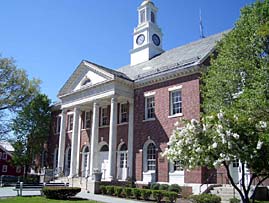
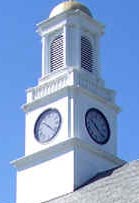
Photos and text by Chris Locke, Sandy Hook, Connecticut


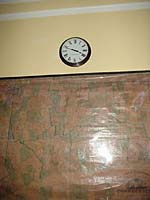


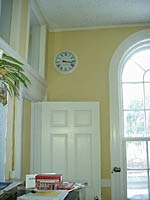
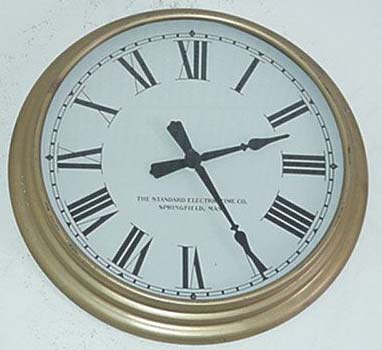

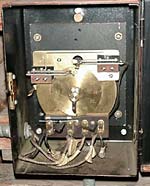
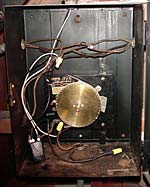


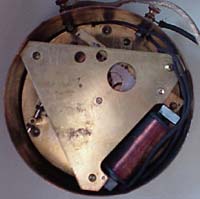




Down the hallway one will find the battery room. The cabinet was restored, and the batteries replaced with a modern version of what was there last installed in 1952. This cabinet remains locked. The original battery charger is long since missing, and was replaced by a Lamarche charger when the batteries were purchased, and can be seen mounted on the wall to the right of the battery cabinet. On the wall to the left of the cabinet is the original battery charger timer, which received pulses from the master clock to regulate how many hours a day the batteries were charged. Since this function is no longer required, it is not hooked up to the current battery charger.
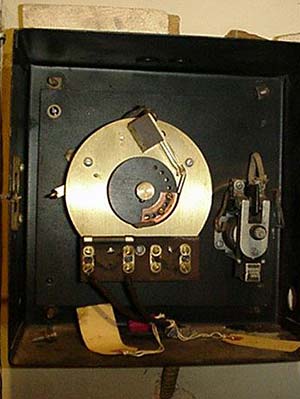

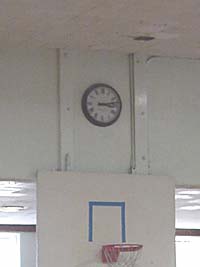


Credits:
The team that restored the clock system is photographed on page 189 of the NAWCC (National Association of Watch and Clock Collectors) Bulletin, Volume 43/2, No. 331, April 2001, and are as follows:
Jim Gardner, who wrote the article, provided assistance during the disassembly of the existing quartz movements, and who also spearheaded the restoration process by providing much needed direction for the various groups (battery/electrical, procurement of parts, disassembly, cleaning, and reassembly, etc).
Chris Locke, myself, who provided engineering and testing information about the battery system, tested the system to ensure operational safety with the existing wiring new charger and battery, provided the source for the replacement batteries, provided and wired the new battery charger, and is one of the two who continues the maintenance of the system.
Dana Blackwell, a continual source of information for all things clockworks, the one responsible for starting the pendulum swinging after close to two and a half decades of rest, cleaned and restored the master clock, and provided a new escape wheel and verge when the original one failed with a broken tooth.
Jim Katzin, worked in the tower on hot days to repaint the faded numerals on the dials, and also secured an electric motor shop owner (member) who replaced the worn bearings and brushes in the bell strike motor.
Jeff Wood, not pictured, whom I first met via a telephone call to inquire about all things Standard Electric, whom I had the pleasure to visit, has provided the most difficult of any pieces of repair parts for this system: Sheet platinum for the replacement drop and finger contacts in the master clock, the original copies of the as-built drawings of the system, including the bell strike mechanism, and entire system schematic, and importantly, a source of parallel electromagnets from which the (new) slave movements were constructed. Movements were donated by various members, but, alas, almost all were series movements.
Last but not least, my very dear friend Jerry Valenta, a continual source of support, and the second person to provide the ongoing maintenance of the system, the person responsible for my introduction to the world of clocks. Jerry re-made the battery cabinet, repaired and rebushed the tower movements, replaced all quartz movements, and walked every step of the restoration process with me. He constantly has clocks torn apart in his shop (town hall clocks of course) and makes the regular trips with me to the town hall to make repairs and adjustments. He originally contacted me due to my work with and knowledge of lead acid storage batteries with AT&T, my employer, but shortly thereafter, a friendship developed, that has permitted us to learn much about each others trade, such that pieces we repair together have a much improved life expectancy.
NEWTOWN, Conn., December 21, 2012 (AP) ? The chiming of bells reverberated throughout Newtown on Friday, commemorating one week since the crackle of gunfire in a schoolhouse killed 20 children and six adults in a massacre that has shaken the community ? and the nation ? to its core.
Gov. Dannel P. Malloy gathered with other officials in rain and wind on the steps of the Edmond Town Hall as the bell rang 26 times in memory of each life lost at Sandy Hook Elementary School. The gunman also killed his mother before the massacre, and himself afterward.
Officials didn't make any formal remark, and similar commemorations took place throughout the country.
~ ~ ~ ~ ~ ~ ~ ~ ~ ~ ~ ~
Jeffrey R. Wood, creator of the Standard Electric Time Co. (SETCO) pages of clockhistory.com, passed away in August of 2018. I will maintain the SETCO web pages in honor of Jeff, but will not be making any additions or changes, or answering any questions. It is hard to express how much I miss Jeff, his friendship, and his wonderful contributions to Standard Electric and Westclox research.
Bill Stoddard